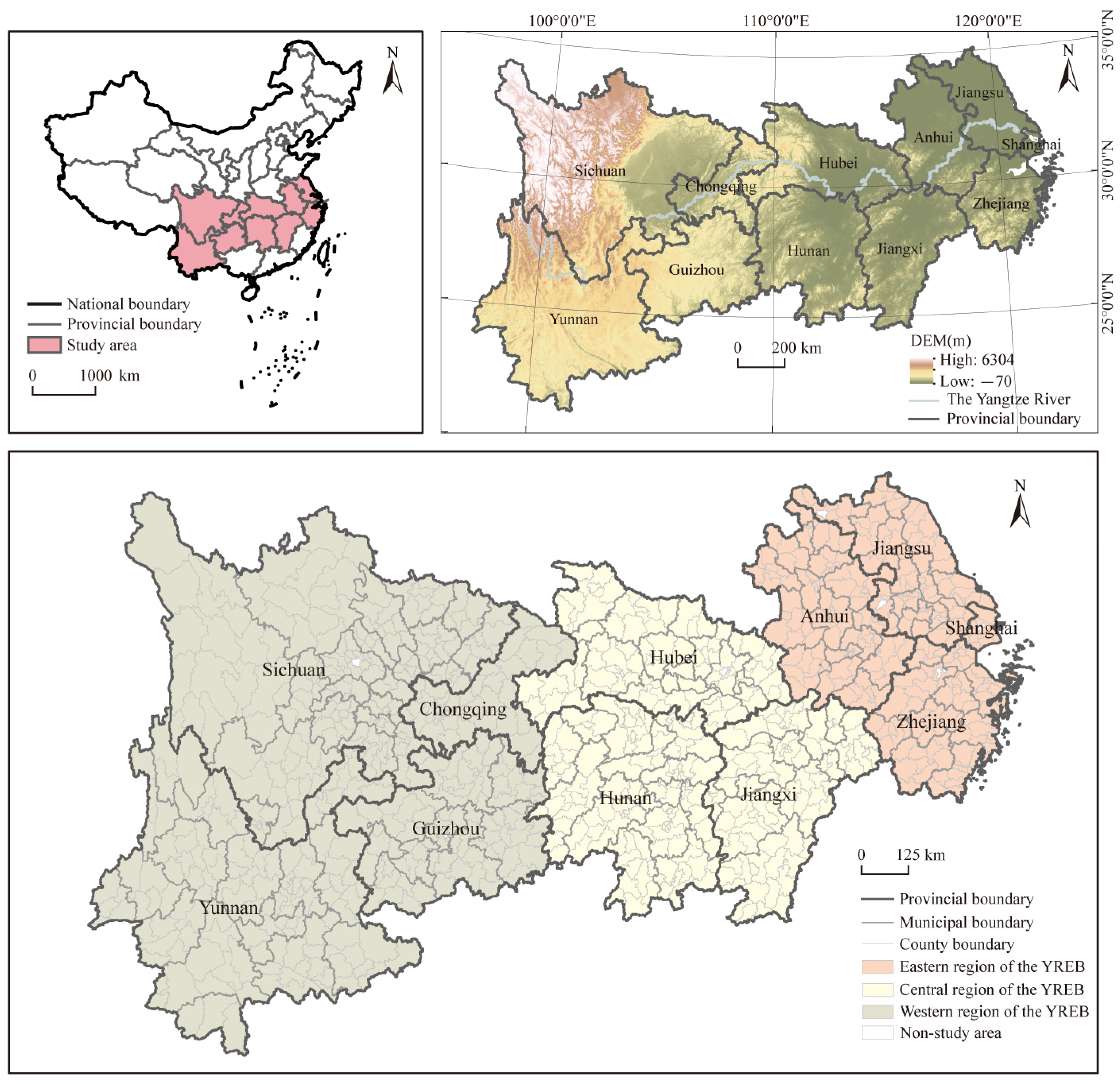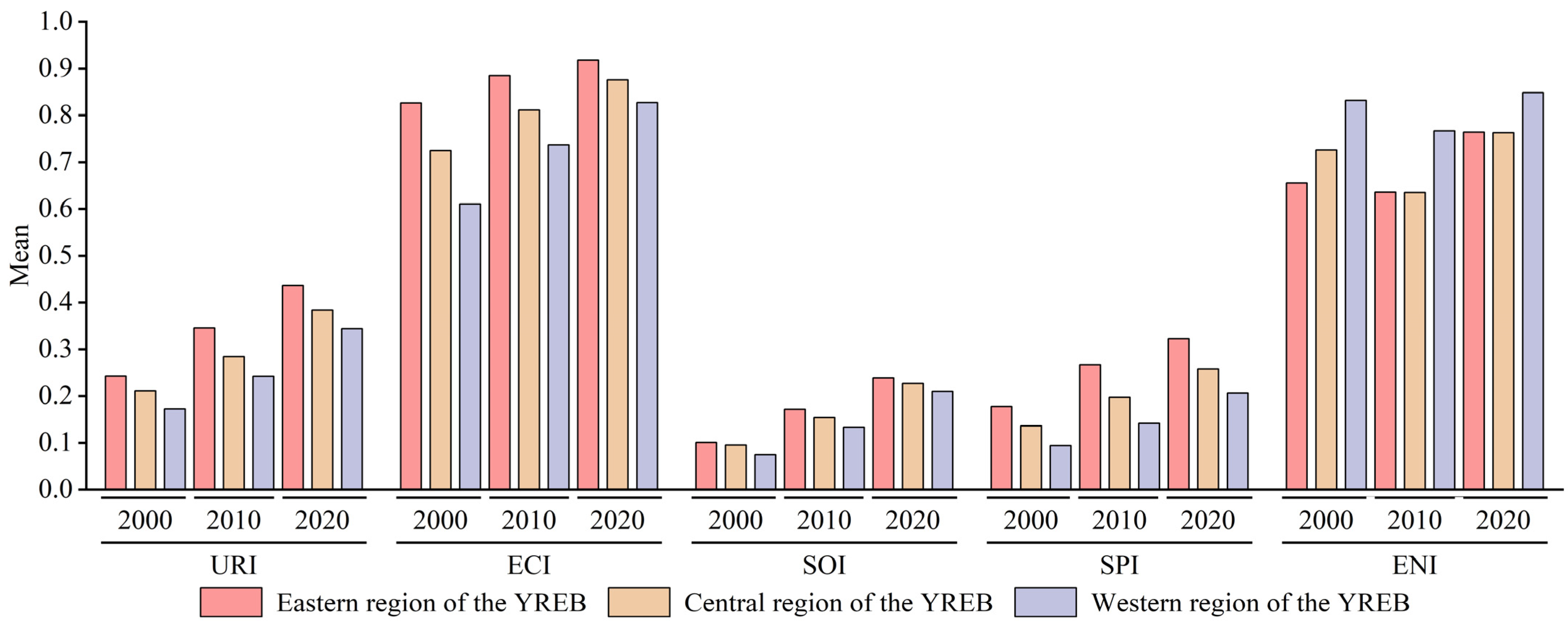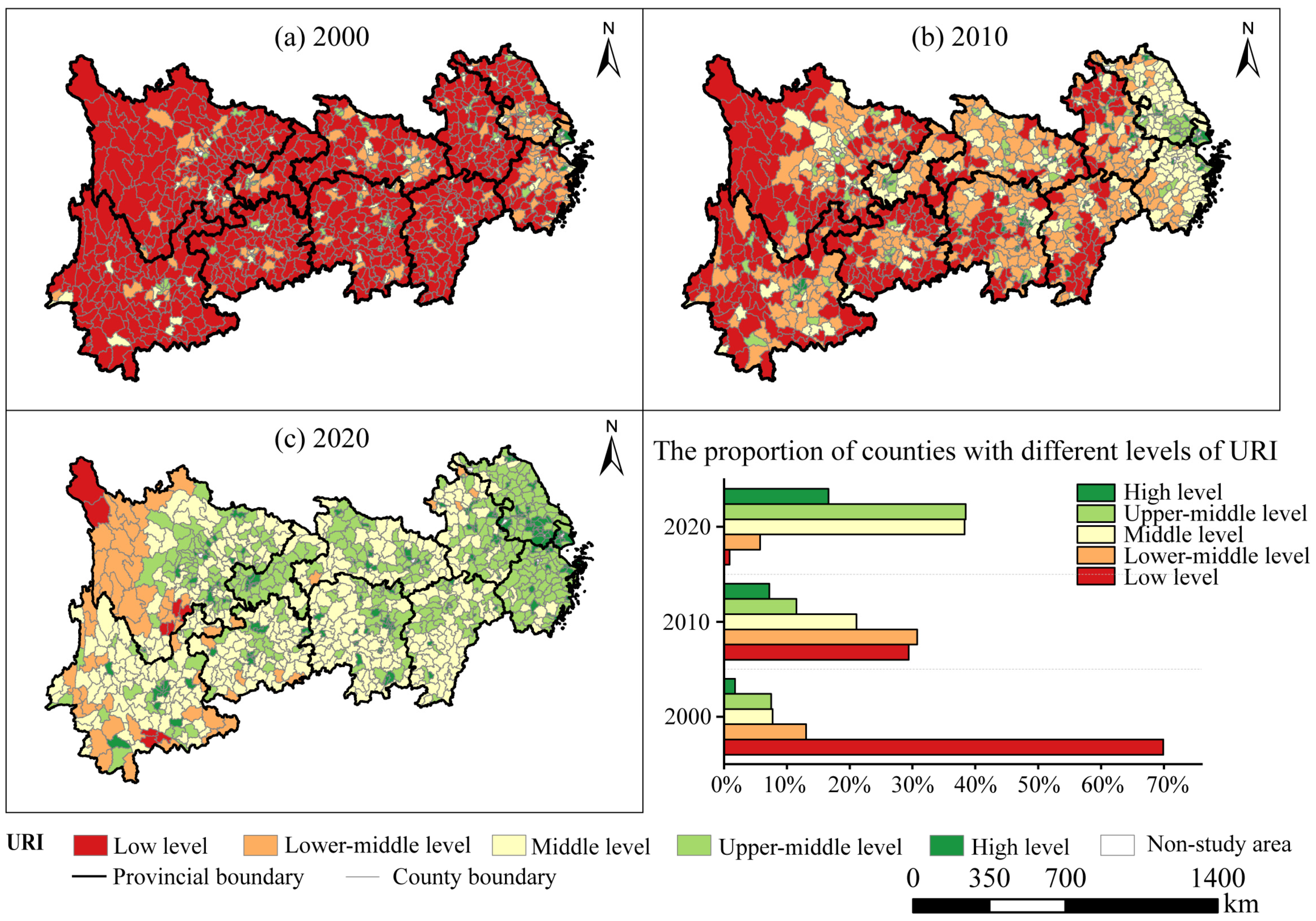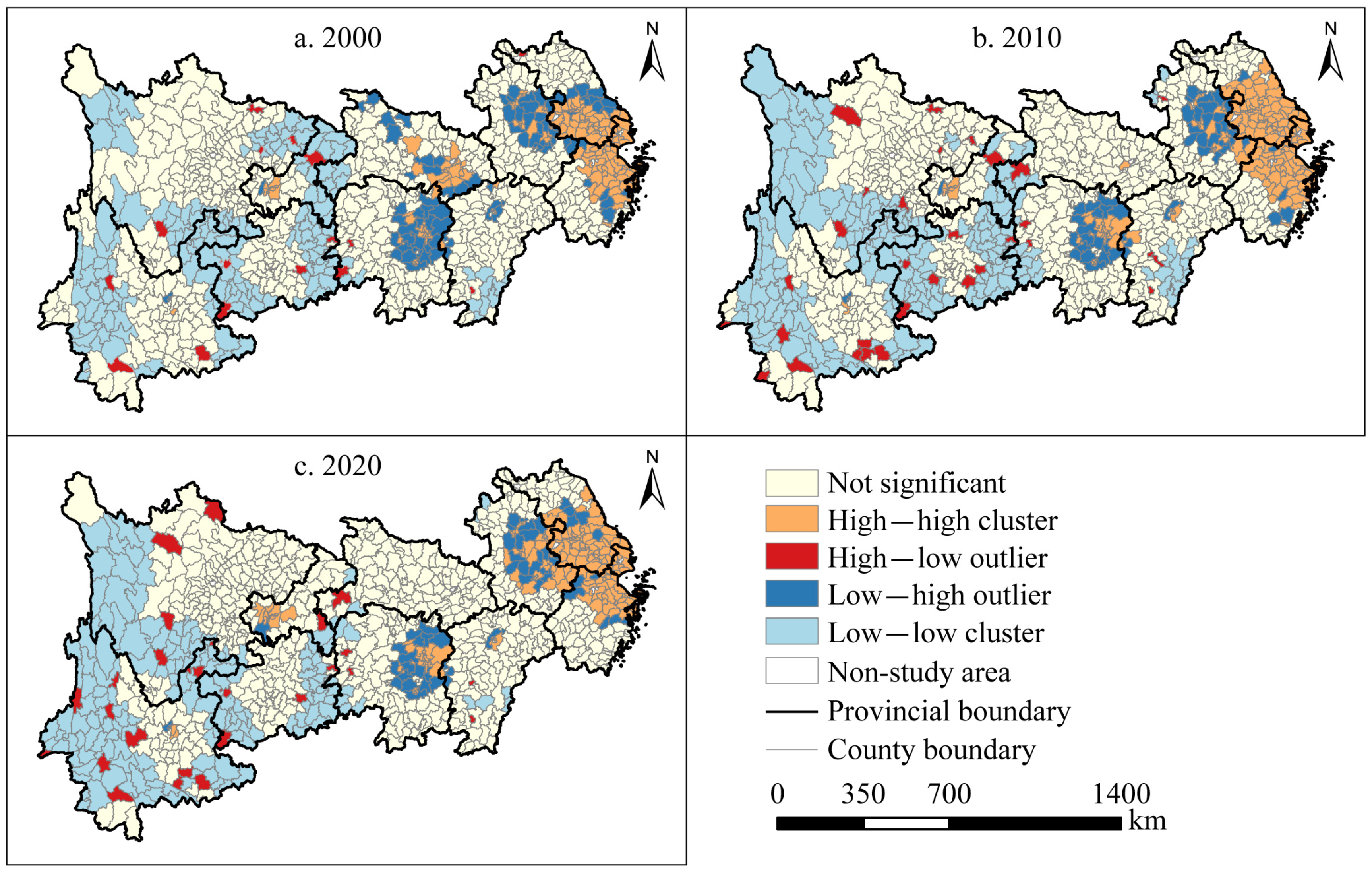Spatiotemporal Differentiation and Driving Factors of Urban–Rural Integration in Counties of Yangtze River Economic Belt
Abstract
1. Introduction
2. Literature Review and Theoretical Framework
2.1. Literature Review
2.2. Theoretical Framework and Evaluation Indicators
3. Materials and Methods
3.1. Study Area
3.2. Methods
3.2.1. Calculation of URI
3.2.2. Local Indicators of Spatial Association (LISA)
3.2.3. Selection of Influencing Factors and Model Analysis
3.3. Data Sources
4. Results
4.1. Spatiotemporal Dynamics of URI
4.1.1. Temporal Variation in URI
4.1.2. Spatial Patterns of URI
4.2. Identification of Drivers
4.3. Spatiotemporal Heterogeneity Effects of Drivers
4.3.1. Model Testing
4.3.2. Spatiotemporal Heterogeneity Effects
5. Discussion
5.1. Spatiotemporal Dynamics and Drivers of URI
5.2. Policy Implications for URI
- (1)
- To address the lag in social and spatial integration within the URI system, the government should enhance the integration of urban and rural public services at the county level. Efforts should also focus on improving the market-based allocation of urban and rural factors, removing institutional barriers to their flow, and strengthening urban–rural transport networks. Additionally, to improve ENI in urban agglomerations, a new urbanization strategy should be implemented to strengthen intensive land use in counties, support low-energy, environmentally friendly enterprises, and reduce traffic pollution [44,47]. Moreover, in line with the rural revitalization policy, efforts should focus on the green transformation of arable land use and reducing the reliance on chemical fertilizers and pesticides.
- (2)
- Spatially, for the low-level URI clusters on the fringes of the western YREB, locally available resources should be fully utilized, and a regional linkage development mechanism should be established. These low-level URI clusters, often characterized by mountainous, hilly, or plateau topographies, are rich in human and natural resources. URI development in these areas should be tailored to local conditions, leveraging human and ecological resources to promote rural tourism, leisure agro-tourism, and other industries, thereby fostering URI through endogenous rural development [50]. Additionally, a regional linkage development mechanism should be established between low-level and high-level URI clusters, enhancing the division of labor, cooperation, and transport connections between regions. This approach will promote URI in low-level agglomerations through a “compensating for weaknesses with strengths” strategy [21].
- (3)
- Given the varying effects of driving factors across regions and over time, development should be adapted to local conditions for an effective approach. In the eastern YREB, URI should focus on low-elevation areas while preserving the natural environment. In the central region, the focus should be on leveraging social investment, enhancing transport networks, and addressing topographical challenges. In the western region, the priority should be placed on economic development, increasing government support, and fostering synergy with the more developed eastern region. The development in the western region should also be adapted to the topographical conditions.
5.3. Strengths and Limitations
6. Conclusions
- (1)
- From 2000 to 2020, URI in the counties of the YREB improved gradually, remaining at a low to medium level. Economic, social, and spatial integration steadily advanced, while environmental integration fluctuated, first declining and then rising. Overall, social and spatial integration lagged behind economic and environmental integration.
- (2)
- Spatially, URI in the YREB counties was characterized by higher levels in the east and lower levels in the west. High–high clusters of URI emerged primarily in the Yangtze River Delta, the middle reaches of the Yangtze River urban agglomeration, and the Chengdu–Chongqing urban agglomeration, highlighting the positive role of urban agglomerations in advancing URI. Additionally, low–low clusters of URI were concentrated at the western provincial borders and in southern Jiangxi, reflecting the lag in URI development in less developed regions.
- (3)
- Economic development, social fixed asset investment, transport accessibility, and the geographical environment drove the spatiotemporal divergence of URI in the YREB counties from 2000 to 2020. Regionally, URI in the eastern YREB was mainly constrained by the altitude. URI in the central YREB was significantly promoted by social fixed asset investment and transport accessibility and constrained by the slope. URI in the western YREB was significantly promoted by economic development and constrained by the slope. Therefore, each region should consider the local effects of drivers and promote URI according to regional conditions.
Author Contributions
Funding
Data Availability Statement
Conflicts of Interest
Appendix A

References
- Lysgård, H.K. The assemblage of culture-led policies in small towns and rural communities. Geoforum 2019, 101, 10–17. [Google Scholar] [CrossRef]
- Fang, C. On integrated urban and rural development. J. Geogr. Sci. 2022, 32, 1411–1426. [Google Scholar] [CrossRef]
- Li, Y.; Westlund, H.; Liu, Y. Why some rural areas decline while some others not: An overview of rural evolution in the world. J. Rural Stud. 2019, 68, 135–143. [Google Scholar] [CrossRef]
- Li, Y.; Jia, L.; Wu, W.; Yan, J.; Liu, Y. Urbanization for rural sustainability–Rethinking China’s urbanization strategy. J. Clean Prod. 2018, 178, 580–586. [Google Scholar] [CrossRef]
- Liu, Y.; Li, Y. Revitalize the world’s countryside. Nature 2017, 548, 275–277. [Google Scholar] [CrossRef]
- McGee, T.G. Managing the rural–urban transformation in east Asia in the 21st century. Sustain. Sci. 2008, 3, 155–167. [Google Scholar] [CrossRef]
- Douglass, M. A regional network strategy for reciprocal rural-urban linkages: An agenda for policy research with reference to Indonesia. Third World Plan. Rev. 1998, 20, 1–33. [Google Scholar] [CrossRef]
- Liu, Y.; Lu, S.; Chen, Y. Spatio-temporal change of urban-rural equalized development patterns in China and its driving factors. J. Rural Stud. 2013, 32, 320–330. [Google Scholar] [CrossRef]
- Yang, Y.; Bao, W.; Wang, Y.; Liu, Y. Measurement of urban-rural integration level and its spatial differentiation in China in the new century. Habitat Int. 2021, 117, 102420. [Google Scholar] [CrossRef]
- Zheng, Y.; Long, H. Measurement and spatio-temporal pattern of urban-rural integrated development in China. Acta Geogr. Sin. 2023, 78, 1869–1887. (In Chinese) [Google Scholar] [CrossRef]
- Chen, C.; LeGates, R.; Zhao, M.; Fang, C. The changing rural-urban divide in China’s megacities. Cities 2018, 81, 81–90. [Google Scholar] [CrossRef]
- Pan, W.; Wang, J.; Li, Y.; Chen, S.; Lu, Z. Spatial pattern of urban-rural integration in China and the impact of geography. Geogr. Sustain. 2023, 4, 404–413. [Google Scholar] [CrossRef]
- Zhao, W.; Pan, W.; Li, Y. Urban-rural integration within the county territory: Theoretical connotation and research progress. Geogr. Res. 2023, 42, 1445–1464. (In Chinese) [Google Scholar] [CrossRef]
- Ma, L.; Liu, S.; Fang, F.; Che, X.; Chen, M. Evaluation of urban-rural difference and integration based on quality of life. Sust. Cities Soc. 2020, 54, 101877. [Google Scholar] [CrossRef]
- Boudet, F.; MacDonald, G.K.; Robinson, B.E.; Samberg, L.H. Rural-urban connectivity and agricultural land management across the global south. Glob. Environ. Change 2020, 60, 101982. [Google Scholar] [CrossRef]
- Zarifa, D.; Seward, B.; Milian, R.P. Location, location, location: Examining the rural-urban skills gap in Canada. J. Rural Stud. 2019, 72, 252–263. [Google Scholar] [CrossRef]
- Baier, N.; Pieper, J.; Schweikart, J.; Busse, R.; Vogt, V. Capturing modelled and perceived spatial access to ambulatory health care services in rural and urban areas in Germany. Soc. Sci. Med. 2020, 265, 113328. [Google Scholar] [CrossRef]
- Seale, E. Coping strategies of urban and rural welfare organisations and the regulation of the poor. New Polit. Econ. 2013, 18, 141–170. [Google Scholar] [CrossRef]
- Liu, H.; Lu, G.; Luo, K.; Zong, H. Measurement and spatio-temporal pattern evolution of urban-rural integration development in the Chengdu-Chongqing economic circle. Land 2024, 13, 942. [Google Scholar] [CrossRef]
- Zhang, S.; Chen, W.; Li, Q.; Li, M. Evaluation and development strategy of urban-rural integration under ecological protection in the Yellow River Basin, China. Environ. Sci. Pollut. Res. 2023, 30, 92674–92691. [Google Scholar] [CrossRef]
- Zhao, W.; Jiang, C. Analysis of the spatial and temporal characteristics and dynamic effects of urban-rural integration development in the Yangtze River Delta region. Land 2022, 11, 1054. [Google Scholar] [CrossRef]
- Liu, M.; Li, Q.; Bai, Y.; Fang, C. A novel framework to evaluate urban-rural coordinated development: A case study in Shanxi province, China. Habitat Int. 2024, 144, 103013. [Google Scholar] [CrossRef]
- Zeng, Q.; Chen, X. Identification of urban-rural integration types in China—An unsupervised machine learning approach. China Agric. Econ. Rev. 2022, 15, 400–415. [Google Scholar] [CrossRef]
- Zhan, L.; Wang, S.; Xie, S.; Zhang, Q.; Qu, Y. Spatial path to achieve urban-rural integration development−Analytical framework for coupling the linkage and coordination of urban-rural system functions. Habitat Int. 2023, 142, 102953. [Google Scholar] [CrossRef]
- He, Y.; Zhou, G.; Tang, C.; Fan, S.; Guo, X. The spatial organization pattern of urban-rural integration in urban agglomerations in China: An agglomeration-diffusion analysis of the population and firms. Habitat Int. 2019, 87, 54–65. [Google Scholar] [CrossRef]
- Su, K.; He, D.; Wang, R.; Han, Z.; Deng, X. Assessment of natural resource endowment and urban-rural integration for sustainable development in Xinjiang, China. J. Clean. Prod. 2024, 450, 142046. [Google Scholar] [CrossRef]
- Adam, A.G.; Dadi, T.T. Perspectives for smooth bridging of dichotomized urban–rural land development in the Peri-urban areas of Ethiopia: Toward a continuum approach. Reg. Sci. Policy Pract. 2024, 16, 12733. [Google Scholar] [CrossRef]
- Garrone, M.; Emmers, D.; Olper, A.; Swinnen, J. Jobs and agricultural policy: Impact of the common agricultural policy on EU agricultural employment. Food Policy 2019, 87, 101744. [Google Scholar] [CrossRef]
- Looney, K.E. Mobilization campaigns and rural development: The east Asian model reconsidered. World Polit. 2021, 73, 205–242. [Google Scholar] [CrossRef]
- Natsuda, K.; Igusa, K.; Wiboonpongse, A.; Thoburn, J. One village one product—Rural development strategy in Asia: The case of OTOP in Thailand. Can. J. Dev. Stud. 2012, 33, 369–385. [Google Scholar] [CrossRef]
- Zhang, X.; Fang, C.; Ma, H.; Hu, X. How does digital economy affect urban-rural integration? An empirical study from China. Habitat Int. 2024, 154, 103229. [Google Scholar] [CrossRef]
- Zhong, S.; Wang, M.; Zhu, Y.; Chen, Z.; Huang, X. Urban expansion and the urban-rural income gap: Empirical evidence from China. Cities 2022, 129, 103831. [Google Scholar] [CrossRef]
- Luo, W.; Wang, W.; Lin, Z.; Zhou, W. Spatiotemporal evolution and driving factors of urban-rural integration in China. Prog. Geogr. 2023, 42, 629–643. (In Chinese) [Google Scholar] [CrossRef]
- Liu, X.; Luo, Y.; Zhu, Y.; Guo, L. Research on the measurement and effects of urban–rural integration and modernization in national central cities. Soc. Indic. Res. 2024, 173, 827–866. [Google Scholar] [CrossRef]
- Sun, Y.; Yang, Q.; Liu, J. Spatio-temporal evolution and influencing factors of integrated urban–rural development in northeast China under the background of population shrinkage. Buildings 2023, 13, 2173. [Google Scholar] [CrossRef]
- Huang, B.; Wu, B.; Barry, M. Geographically and temporally weighted regression for modeling spatio-temporal variation in house prices. Int. J. Geogr. Inf. Sci. 2010, 24, 383–401. [Google Scholar] [CrossRef]
- Zhou, D.; Qi, J.; Zhong, W. Review of urban-rural integration evaluation: Connotation identification, theoretical analysis, and system reconstruction. J. Nat. Resour. 2021, 36, 2634–2651. (In Chinese) [Google Scholar] [CrossRef]
- Zhang, X.; Han, L.; Wei, H.; Tan, X.; Zhou, W.; Li, W.; Qian, Y. Linking urbanization and air quality together: A review and a perspective on the future sustainable urban development. J. Clean. Prod. 2022, 346, 130988. [Google Scholar] [CrossRef]
- Dai, H.; Huang, G.; Zeng, H.; Yu, R. Haze risk assessment based on improved PCA-MEE and ISPO-LightGBM model. Systems 2022, 10, 263. [Google Scholar] [CrossRef]
- Anselin, L. Local indicators of spatial association-LISA. Geogr. Anal. 1995, 27, 93–115. [Google Scholar] [CrossRef]
- Ullah, I.; Dagar, V.; Tanin, T.I.; Rehman, A.; Zeeshan, M. Agricultural productivity and rural poverty in China: The impact of land reforms. J. Clean. Prod. 2024, 475, 143723. [Google Scholar] [CrossRef]
- Wang, J.; Xu, C. Geodetector: Principle and prospective. Acta Geogr. Sin. 2017, 72, 116–134. (In Chinese) [Google Scholar] [CrossRef]
- Liu, H.; Cui, W.; Zhang, M. Exploring the causal relationship between urbanization and air pollution: Evidence from China. Sust. Cities Soc. 2022, 80, 103783. [Google Scholar] [CrossRef]
- Chen, S.; Tan, Z.; Mu, S.; Wang, J.; Chen, Y.; He, X. Synergy level of pollution and carbon reduction in the Yangtze River Economic Belt: Spatial-temporal evolution characteristics and driving factors. Sust. Cities Soc. 2023, 98, 104859. [Google Scholar] [CrossRef]
- Wu, Q.; Chang, W.; Song, M.; Zhu, H. Measurement of urban-rural integration development level and diagnosis of obstacle factors: Evidence from the Beijing-Tianjin-Hebei urban agglomeration, China. Land 2025, 14, 261. [Google Scholar] [CrossRef]
- Tong, Y.; Liu, W.; Li, C.; Rong, Y.; Zhang, J.; Yang, Y.; Yan, Q.; Gao, S.; Liu, Y. County town shrinkage in China: Identification, spatiotemporal variations and the heterogeneity of influencing factors. J. Rural Stud. 2022, 95, 350–361. [Google Scholar] [CrossRef]
- Wang, N.; Li, S.; Kang, Q.; Wang, Y. Exploring the land ecological security and its spatio-temporal changes in the Yangtze River Economic Belt of China, 2000–2020. Ecol. Indic. 2023, 154, 110645. [Google Scholar] [CrossRef]
- Zhang, D.; Kong, Q.; Shen, M. Does polycentric spatial structure narrow the urban-rural income gap? – Evidence from six urban clusters in China. China Econ. Rev. 2023, 80, 101999. [Google Scholar] [CrossRef]
- Li, Y.; Wu, S.; Yan, B. Spatial characteristics and influential mechanism of the coupling coordination degree of urban accessibility and human development index in China. Environ. Sci. Pollut. Res. 2022, 29, 29793–29807. [Google Scholar] [CrossRef]
- Gao, J.; Wu, B. Revitalizing traditional villages through rural tourism: A case study of Yuanjia village, Shaanxi province, China. Tour. Manag. 2017, 63, 223–233. [Google Scholar] [CrossRef]







| Layer | Code | Indicator | Calculation or Description | Category | Attribute | Weight |
|---|---|---|---|---|---|---|
| ECI | X1 | The ratio of agricultural to non-agricultural employment (%) | (Primary industry employees/employees in secondary and tertiary industries) × 100% | Interactive | Negative | 0.348 |
| X2 | The ratio of the output values of secondary and tertiary industries (%) | (Output value of secondary and tertiary industries/GDP) × 100% | Interactive | Positive | 0.333 | |
| X3 | Binary comparison coefficient (%) | (Primary industry output/primary industry employees)/(secondary and tertiary industry output/secondary and tertiary industry employees) | Comparative | Positive | 0.021 | |
| X4 | Per capita income ratio between urban and rural residents (%) | (Per capita disposable income of urban residents/per capita disposable income of rural residents) × 100% | Comparative | Negative | 0.298 | |
| SOI | X5 | Beds per 10,000 population in urban and rural areas (beds per 10,000 population) | (Medical beds in urban and rural areas/total population) × 10,000 | Overall | Positive | 0.338 |
| X6 | Healthcare technicians per 1000 population in urban and rural areas (persons per 1000 population) | (Healthcare technicians in urban and rural areas/total population) × 1000 | Overall | Positive | 0.360 | |
| X7 | Teacher–student ratio in urban and rural primary and secondary schools | (Teachers at primary and secondary schools in urban and rural areas/students at primary and secondary schools in urban and rural areas) × 100% | Overall | Positive | 0.302 | |
| SPI | X8 | Population urbanization (%) | (Urban resident population/total population) × 100% | Interactive | Positive | 0.365 |
| X9 | Land urbanization (%) | (Urban construction land area/total land area) × 100% | Interactive | Positive | 0.337 | |
| X10 | Urban and rural road network density (km/km2) | Mileage of urban and rural highways/total land area | Overall | Positive | 0.298 | |
| ENI | X11 | PM2.5 in urban and rural areas | — | Overall | Negative | 0.371 |
| X12 | Fertilizer usage per unit area of cultivated land in urban and rural areas (t/hm2) | Fertilizer usage/cultivated land area | Overall | Negative | 0.278 | |
| X13 | Pesticide usage per unit area of cultivated land in urban and rural areas (t/hm2) | Pesticide usage/cultivated land area | Overall | Negative | 0.351 |
| Driver | Code | Factor | Calculation or Description | Unit |
|---|---|---|---|---|
| Economic factor (D1) | F1 | Per capita GDP (PGDP) | GDP/total population | CNY 10,000/person |
| F2 | Industrial structure advancement degree (ISAD) | Value added from tertiary industry/value added from secondary industry | — | |
| Policy factor (D2) | F3 | Per capita public financial input (PPFI) | Public financial input/total population | CNY 10,000/person |
| F4 | Per capita social fixed asset investment (PSFAI) | Social fixed asset investment/total population | CNY 10,000/person | |
| Technological factor (D3) | F5 | Transportation network density (TA) | Mileage of urban and rural highways/total land area | km/km2 |
| F6 | Power of agricultural machinery per unit of cultivated land (PPAM) | Total power of agricultural machinery/cultivated land area | kW/hm2 | |
| Geographical environment factor (D4) | F7 | Average elevation (AE) | The average elevation of each county | m |
| F8 | Average slope (AS) | The average slope of each county | — |
| Factor | 2000 | 2010 | 2020 | Mean q-Value | |||
|---|---|---|---|---|---|---|---|
| q-Value | p-Value | q-Value | p-Value | q-Value | p-Value | ||
| PGDP (F1) | 0.233 | 0.000 | 0.453 | 0.000 | 0.354 | 0.000 | 0.347 |
| ISAD (F2) | 0.062 | 0.000 | 0.018 | 0.979 | 0.010 | 0.955 | 0.030 |
| PPFI (F3) | 0.043 | 0.008 | 0.032 | 0.057 | 0.089 | 0.000 | 0.054 |
| PSFAI (F4) | 0.294 | 0.000 | 0.277 | 0.000 | 0.071 | 0.000 | 0.214 |
| TA (F5) | 0.064 | 0.000 | 0.158 | 0.000 | 0.227 | 0.000 | 0.150 |
| PPAM (F6) | 0.073 | 0.000 | 0.043 | 0.054 | 0.006 | 0.996 | 0.041 |
| AE (F7) | 0.140 | 0.000 | 0.187 | 0.000 | 0.183 | 0.000 | 0.170 |
| AS (F8) | 0.147 | 0.000 | 0.197 | 0.000 | 0.219 | 0.000 | 0.188 |
| Parameter | OLS | GWR | GTWR |
|---|---|---|---|
| Bandwidth | — | 0.1150 | 0.1118 |
| AIC | −4645.0984 | −5137.5100 | −5655.6900 |
| R2 | 0.5494 | 0.6259 | 0.6944 |
| R2—adjusted | 0.5487 | 0.6253 | 0.6939 |
| RSS | 39.4970 | 32.8016 | 26.7998 |
Disclaimer/Publisher’s Note: The statements, opinions and data contained in all publications are solely those of the individual author(s) and contributor(s) and not of MDPI and/or the editor(s). MDPI and/or the editor(s) disclaim responsibility for any injury to people or property resulting from any ideas, methods, instructions or products referred to in the content. |
© 2025 by the authors. Licensee MDPI, Basel, Switzerland. This article is an open access article distributed under the terms and conditions of the Creative Commons Attribution (CC BY) license (https://creativecommons.org/licenses/by/4.0/).
Share and Cite
Dong, Y.; Li, L.; Huang, X. Spatiotemporal Differentiation and Driving Factors of Urban–Rural Integration in Counties of Yangtze River Economic Belt. Land 2025, 14, 889. https://doi.org/10.3390/land14040889
Dong Y, Li L, Huang X. Spatiotemporal Differentiation and Driving Factors of Urban–Rural Integration in Counties of Yangtze River Economic Belt. Land. 2025; 14(4):889. https://doi.org/10.3390/land14040889
Chicago/Turabian StyleDong, Youming, Long Li, and Xianjin Huang. 2025. "Spatiotemporal Differentiation and Driving Factors of Urban–Rural Integration in Counties of Yangtze River Economic Belt" Land 14, no. 4: 889. https://doi.org/10.3390/land14040889
APA StyleDong, Y., Li, L., & Huang, X. (2025). Spatiotemporal Differentiation and Driving Factors of Urban–Rural Integration in Counties of Yangtze River Economic Belt. Land, 14(4), 889. https://doi.org/10.3390/land14040889







